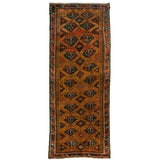Art Monkey
Nomadic Zabol Persian Carpet 122x306
This nomadic Zabol Persian carpet showcases expert handweaving, intricate geometric patterns, and natural dyes, reflecting the region's rich cultural heritage and craftsmanship
PRODUCT DESCRIPTION
| Kind: Carpet |
| Design:Nomadic |
| Material: Wool with plant-based dye |
| Origin: Zabol |
| Color: Copper |
|
Width: 122 cm Length: 306 cm Area: 373 cm |
| Shipping: Free delivery in UAE within 7 business days |
More information
The nomadic Zabol Persian carpet is a distinctive handwoven rug crafted by the nomadic and semi-nomadic tribes in the Zabol region, located in southeastern Iran, near the Afghan border.
This carpet is highly valued for its intricate design, exceptional craftsmanship, and strong connection to the cultural heritage of the Baluch tribes, who have long been associated with this region.
key characteristics of Nomadic Zabol Persian Carpet
Weaving Technique
- Flat-Weave and Knotted Carpets: The carpets from Zabol come in both flat-weave (kilim) and knotted varieties. They are handwoven using traditional techniques passed down through generations of artisans.
- High Knot Density: The knotted carpets from Zabol are known for their relatively high knot density, which enhances their durability and contributes to their fine, detailed patterns.
- Geometric Patterns: These rugs often feature bold geometric designs, including diamonds, zigzags, and repeating motifs that are typical of tribal Persian carpets.
Materials
- Wool: The primary material used in Zabol carpets is high-quality wool sourced locally from sheep. This wool is known for its softness and durability.
- Natural Dyes: Like other traditional Persian carpets, those from Zabol are dyed using natural materials, such as plants, minerals, and insects. These natural dyes produce deep, earthy tones like rich reds, dark blues, browns, and blacks.
Colors
- Earthy Tones: The color palette of nomadic Zabol Persian carpet typically includes deep reds, browns, blacks, and navy blues, which reflect the natural dyes and the desert landscape of the region.
- Contrasting Accents: Brighter colors like white, orange, or light blue are occasionally used to create contrast and highlight key design elements within the carpet.
Design Elements
- Tribal Motifs: The designs of Zabol carpets reflect the nomadic culture of the region, often incorporating tribal symbols such as stars, flowers, camels, animals, and trees. Each motif carries cultural significance and tells stories about the tribe's way of life, beliefs, and surroundings.
- Symmetrical Designs: Many Zabol carpets exhibit a high degree of symmetry in their patterns, with repeating elements organized into medallions or all-over designs.
- Minimal Borders: The borders in Zabol carpets are often narrow and secondary to the central field, which is dominated by intricate, repeating motifs.
- Small to Medium Sizes: Zabol carpets tend to be smaller in size compared to urban Persian rugs, which is characteristic of nomadic carpets. They are often woven for practical, portable use, such as small floor coverings, saddle blankets, or wall hangings.
Functionality
- Multi-Purpose:The nomadic Zabol Persian carpet serves various purposes, ranging from a floor covering to a tent decoration or wall hanging. Its durable construction makes it suitable for both functional and decorative use.
- Portable: Due to their lighter weight and smaller size, these carpets were traditionally designed to be portable and easy to transport, aligning with the nomadic lifestyle of the Baluch tribes.
Cultural Significance
- Nomadic Traditions: Zabol carpets are a reflection of the nomadic heritage of the Baluch tribes, who have inhabited the region for centuries. The patterns, symbols, and craftsmanship carry deep cultural meaning, representing the history, beliefs, and environment of the people who create them.
- Heritage Passed Through Generations: The weaving techniques and motifs used in nomadic Zabol Persian carpet is passed down from generation to generation, preserving the rich traditions of the nomadic lifestyle.
- Durability: Long-Lasting. Zabol carpets are highly durable and made to withstand the harsh conditions of a nomadic lifestyle. The quality wool and high knot density ensure that these rugs remain in good condition, even with regular use.
Types of Zabol Carpets
- Flat-Weave (Kilim): These are thinner, flat-woven rugs without a pile, known for their lightweight and flexibility, making them ideal for both decorative and functional use.
- Pile Carpets: The knotted carpets from Zabol have a soft pile and offer a luxurious texture while maintaining durability.
Uses in Modern Interiors
The Nomadic Zabol Persian carpet offers a perfect blend of traditional artistry, cultural significance, and practical functionality. With its intricate design, high-quality materials, and strong ties to the nomadic lifestyle, this carpet is highly valued by collectors and those who appreciate authentic, handcrafted pieces with a rich history.
Note: For more detailed images and videos of this nomadic Zabol Persian carpet, please contact us directly.View the full collection here
CARE
Vacuum your nomadic Zabol Persian carpet regularly to extend your rug’s life.
Air it out to help prevent moisture buildup.
Rotate to distribute wear and fading.
Avoid excessive sunlight to prevent fading.
Clean spills immediately to minimize damage.
Use under-rug padding for multiple benefits.
Be mindful of furniture placement.
Supervise pets around the rug.
Call the pros for occasional deep cleans.








